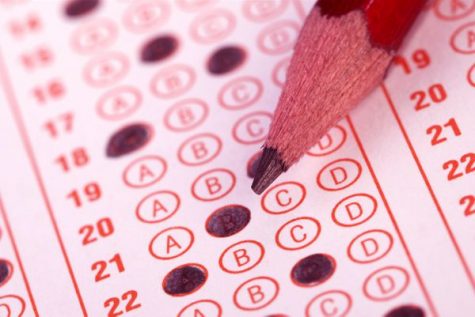Students and staff prepare to implement Achievement-Based Grading
February 6, 2016
New Berlin West will be implementing Achievement-Based grading for the 2016-17 school year. This extensive change has raised many questions. Without being educated on the process and specifics of Achievement-Based grading, it is easy to be confused. Concerns have risen about how these changes will affect transcripts, GPAs, information colleges receive, and a variety of other aspects that affect students’ futures.
Tammy Heflebower, Vice President of Marzano Research Laboratory, published an article called “Grades that Show what Students Know” that gives an example scenario involving Achievement-Based Grading: “Figure 1—patterns and data analysis. Let’s assume that 35 of the 100 points deal with patterns and 65 of the 100 points address data analysis. Now consider two students, both of whom have attained a score of 70. The first student might have acquired all 35 of the 35 points on patterns but only 35 of the 65 points on data analysis. The student has demonstrated a robust understanding of patterns but only a partial understanding of data analysis. The second student might have received only 5 of the 35 points on patterns but all 65 points on data analysis. This student has demonstrated an opposite pattern. The convention of designing tests that involve more than one topic and then scoring these tests using the 100-point (or percentage) scale makes it impossible to gauge individual students’ knowledge.”
Along with Heflebower, Dr. Eileen Depka, Director of Continuous Improvement in the District of New Berlin, believes the 100 point scale doesn’t accurately reflect student achievement.
“[The 100 point scale] is a very unbalanced system where a four point system is an equal weight so it’s much fairer,” says Depka.
Depka gave the example of a student who gets a 100, 100, 100, 100 and a 0 as their grades. To find an average grade using the old system, it comes out to be an 80%, or a B-.
“That zero skews that grade,” Depka stated. “It no longer accurately reflects the fact that ⅘ times that student was able to perfectly perform.”
On the new grading scale, the same student previously mentioned would receive a 4, 4, 4, 4, and a 1, respectively. The scale would then calculate out as 17 points divided by 5 scores, resulting in a 3.4. This is, as Depka states, “much closer to that A/B range which is where the student is actually performing.”
Along with the issue of not fully reflecting student achievement, the 100 point system poses another problem.
“I think one of the biggest problems was the use of a scale that heavily weighed an F, so on a 100 point scale there were 60 points in there that could give a student an F, but there were only 10 that could get them to an A,” says Depka.
These prominent issues have led the district to allow teachers to pilot Achievement-Based grading so teachers can become more familiar with it before the shift is enforced district-wide.
“I decided to pilot the system this year to get ahead of the game and get more familiar with how it functions so that I can use summer time to prepare my course work for that,” says Diane Hudaj, an educator at New Berlin West.
As an instructor teaching multiple courses, Hudaj hasn’t seen major complications with the system, but the transition in itself is something to get used to.
“It’s a change and a transition and people don’t love that all the time, especially since we have had multiple changes this year, like scheduling and the new principle. It’s been a time consuming transition for me as the professional dealing with it,” Hudaj explains, “and it’s hard to communicate expectations and what the system is and does with students when it’s not always made clear to us. But what I’m finding is that it’s going to increase student awareness of their own skills and abilities and also give them a more clear picture of how they’re earning a grade, mark, or score.”
Change is a major adjustment, but the hope is that it will ultimately be beneficial for students.
“I think it’s the change, there is always something in getting used to change,” says Dr. Depka, “but I think with Standards-Based grading we are focusing on the right things and we are getting rid of a percent system that really was a disadvantage to students.”
Although this shift has yet to be put into effect, it is still important to the the district that parents and students are involved in the conversion process.
“There are a lot of things happening right now within the next few weeks and there will be more information going to students, parents, and teachers. Not only about what will be taking place this year, but next year as well,” Depka confirms.
The overall goal of this transformation is to correctly show the students capabilities in the subject.
“The goal was to take anything out of a grade that isn’t reflected of achievement. For example, timeliness doesn’t say how well someone knows something, it shows how fast they hand it in, or bringing in something for extra credit doesn’t mean you know something more about the subject, it means that you brought in, in some cases, a tissue box. So the goal was to have the system reflect accurately what students can do,” explains Depka.
Looking ahead, this system is believed to still be a good measure of grading in years to come. “I think again we are looking at accurately reflecting what a student knows and can do and that’s really what we need to do and our job in education is to help students learn as much as they possibly can while they are in school,” says Depka, “so the shift is a good shift, and a change that is positive that we want to see made, because that is the shift that needs to be made in life, It’s not about a grade you get. When you get out of school, in post secondary school or in a workplace it’s not about a grade you’re going to get, it’s about how you learn and how you are going to fulfill your responsibilities.”












